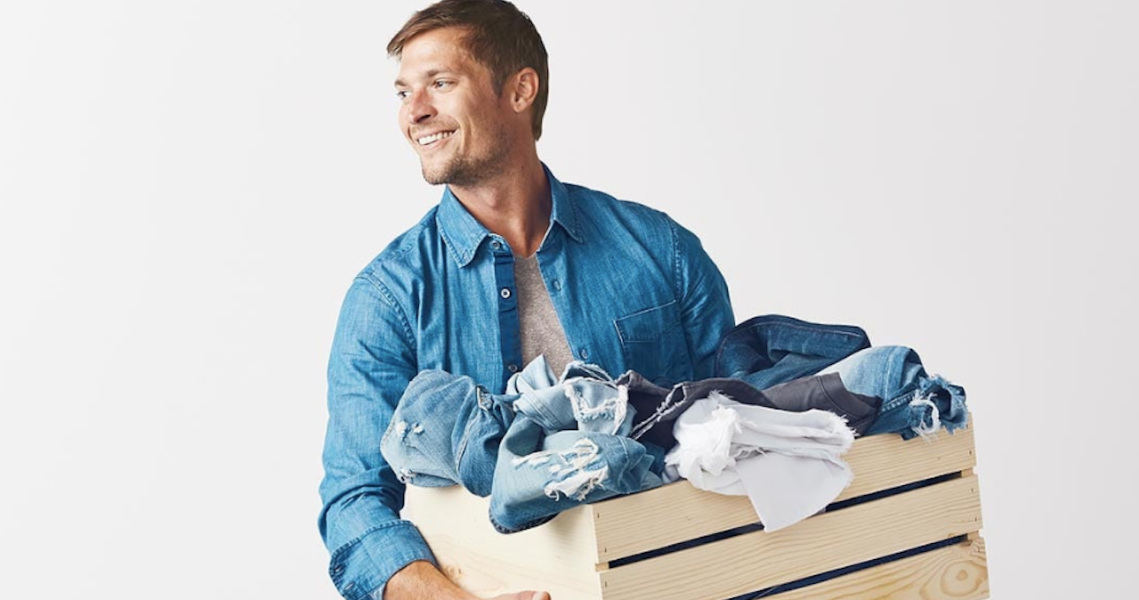J. Crew debuted this week a new program in partnership with Habitat for Humanity, in which it buys back old pairs of jeans to be recycled into insulation material for the housing company.
J. Crew has only dabbled in denim recycling thus far. Since 2014, J. Crew has offered a limited denim recycling program with a company called Blue Jeans Go Green, which recycles the material. The new effort brings in Habitat for Humanity, which will help ensure that all of the recycled denim gets put to good use.
To incentivize customers to recycle their denim with J. Crew, the brand is offering $20 toward a new pair of jeans for every pair brought in. That’s generous, compared to like programs by brands like Rag & Bone and A.P.C., which only offer a percentage discount, usually around 10-20 percent (although A.P.C. offers 50 percent for some styles) on future purchases. Any pair of jeans can be turned in, not just pairs purchased at J. Crew. Other brands, including the aforementioned Rag & Bone and A.P.C., typically require that the recycled product be from the brand.
This is a big swing for J. Crew, which has continued to live in the shadow of its far more successful sister brand Madewell. In the second quarter of fiscal year 2018, J. Crew’s sales dropped by 5 percent while Madewell’s grew by 29 percent.
“Our denim recycling program allows us to help our customers dispose of waste responsibly by giving their jeans a new life in the form of housing insulation and keeping them out of landfills,” said Gonzalo Pertile, director of corporate social responsibility at J.Crew. “This is one of the steps we’re taking as we embark in our sustainability journey. We believe that some challenges require strong partnerships to make the most meaningful impact.”
J. Crew’s denim recycling efforts are in line with a trend running through the fashion industry toward minimizing the amount of waste and excess material introduced into circulation. Ever since the Burberry clothes-burning scandal in July, fashion consumers have become more aware of the problem of wasted excess clothing. Buyback programs like J. Crew’s recycling initiative are common, but they do not address a related problem: the overproduction of goods.
J. Crew has a reputation for constant sales and the heavy movement of product, which can be a signal of an overproduction problem. According to a December 2018 report from retail software company ShareCloth, 12.8 million tons of clothing are dumped into landfills each year. Brands typically struggle with accurately gauging exactly how much product they will need to make, and so they produce far too much of it, much of which goes unsold or is thrown out soon after being worn.
“The key is to design clothes from the offset that can be recycled and to slow down the fashion cycles,” said Diana Verde Nieto, co-founder and CEO of Positive Luxury, an organization promoting sustainability within luxury fashion. “Do we really need eight collections a year? The circular economy is a reality. In my view, more and more companies should really understand the adoptions of those principals when designing and manufacturing collections.”
J. Crew’s denim recycling program is generous. Twenty dollars per pair of jeans, even those not from the brand, is a significant investment in taking some of the excess product that might otherwise end up in a landfill out of circulation and putting it toward a good cause. But, up until now, J. Crew’s larger sustainability efforts have been lacking.
An analysis last August by Good On You, a company that rates brands based on their sustainability efforts, pointed out that J. Crew has ill-defined policies on how its goods are to be produced and what level of emissions stem from its production processes. Removing existing jeans from circulation is admirable, but it does not address the problem of producing far too much product to begin with.
“We are conscious of the large amounts of textiles that are thrown out every year in the world, so as apparel brands, we need to find new ways to help,” said Pertile. “Our partnerships with Habitat for Humanity and Blue Jeans Go Green are together just one step that we are taking to try and make an impact where we can.”
Still, becoming a sustainable brand is a process, and some brands do far less than what J. Crew’s new buyback program is doing to reduce the amount of apparel waste in landfills. As sustainability becomes increasingly important to consumers, brands have to work toward creating more comprehensive sustainabilty goals.
“Ideally, they would do more, but it’s great that J. Crew is taking this initiative,” Nieto said. “Creating a new line from pre-loved clothes while also encouraging consumers to create an emotional bond to the brand, is a smart move and puts pressure to other brands to do the same.”




